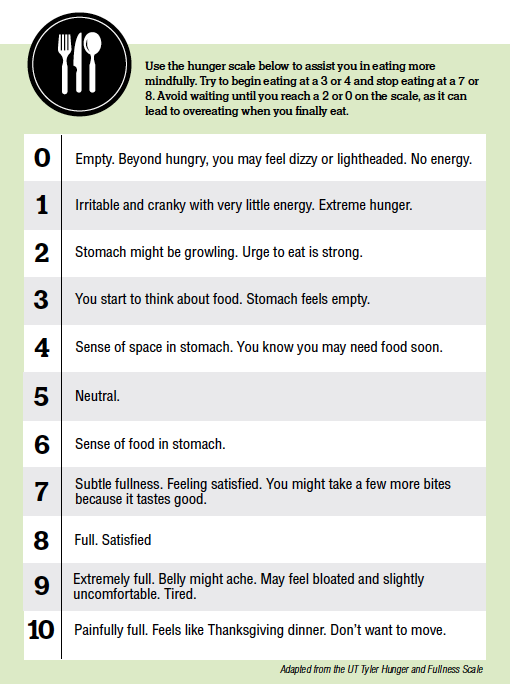January brings a lot of well-intentioned goal setting for all areas of life. I especially love that the New Year can represent a clean slate and pave the way for healthy habits. It can be tempting to fall into the trap of starting yet another fad diet, detox or cleanse, but I’m hoping to introduce you to a new approach. Out are the days of counting every calorie. Instead, welcome a new attitude toward food by tuning in to your body and practicing mindful eating!
Mindfulness is a practice that involves paying attention to both emotional and physical states as well as the environment around you. When applied to eating, mindfulness can be an effective method of managing chronic disease and promoting weight loss or management. The application of mindfulness to eating emphasizes the non-judgment of food choices; there’s no need to label foods as “good” or “bad.” In other words, we are not attaching morals to our food choices. This approach can also be referred to as intuitive eating.
How?
To practice mindful or intuitive eating, it is important to consider the internal and external cues that influence what, when and how much we eat. Think about a strict fad diet and the rules associated with adhering to it.
In this example, the cues are external; we rely on the rules of the diet to tell us what foods we are allowed to eat, which ones are off limits and what times of day eating is permitted. Even if we are starving at 9 p.m., we don’t eat because these external rules have already dictated our choice. There’s no freedom at all with this approach!
Alternatively, think about listening to your body and making food decisions based on those cues. Our bodies are incredibly smart, but if we continuously ignore internal signals, it becomes difficult to tune in to them. Try eating when you begin to feel hungry (you may feel your stomach is empty or you might be having increased thoughts about food), and pay attention throughout the meal so you are able to recognize when fullness sets in. Notice the texture, flavor and temperature of the food as you chew it. This method is truly internal, as we rely on how our body and mind feel.
Mindful eating allows for more flexibility, freedom and enjoyment of our foods. When we eat in this way, our bodies often surprise us; we feel a true desire for nutritious foods that make our bodies feel good and function at their best. We seek variety and consume a diverse spectrum of nutrients.
On a diet, there is always going to be the hidden threat of deprivation. This fear that we will never have another cookie, doughnut or piece of pizza increases desire for the very foods we rule off limits! Ultimately these strict diets backfire and we are back where we started in the diet. It’s a cycle of binge eating, guilt and shame. However, when we consciously choose to eat dessert, we don’t feel as if we have “cheated.” This is because with mindful eating, YOU are in control. When adhering to a diet, you lack this control, which is why we so often find ourselves “falling off the wagon.”
If you want to implement these principles into your life, it is important to separate yourself from the messages that bombard us through society and the media. These messages place an unrealistic image and pressure on women and men to achieve the “ideal” shape and size. We are all different, and the diet that works for one person might be a complete disaster for another. The faster you recognize that diets fail, the easier intuitive eating will be. Once we outsmart the diets, it is empowering to have confidence in our bodies to know exactly what they need to be healthy.
Mindful or intuitive eating is a wonderful tool to help foster a healthier relationship with food and our bodies. So often I meet with people who berate themselves because of their food choices. There is so much stress, shame and guilt surrounding eating. Mindfulness can help us break away from these harsh attitudes. There is no wrong way to practice mindful eating. Focus on an increased awareness and a consistent recognition of thoughts that come up throughout the process. Take a step back when you hear distorted thoughts and try reframing them.
An example might be when you hear that voice in the back of your head saying, “If I eat this brownie, I will get fat.” Instead of believing the automatic thought, think about some alternatives such as, “If I eat this brownie, I will feel satisfied and my craving will be gone,” or “This is a special recipe and I might enjoy eating this while I have coffee with my friend.” When we begin to remove the rules and really tune in to what our bodies are telling us, we often find our way to a naturally healthy weight that is easy to maintain with relaxed, nutritious and fun eating along with conscious movement and exercise.
Use this guide to help:

Related articles:
5 Items To Brighten Up Nighttime Workouts
Ted Talks: Putting Solution Into Resolution! Let’s Go, 2021!
Use These Online Resources To Workout With Your Kids!
4 Classic Champagne Drinks For Any Occasion
How Can You Use Food As Skincare?
Enjoy Savory Pumpkin Bruschetta This Fall

